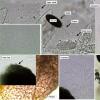
23-01-2014 21:08
Hi to all,I found this Pyrenomycete in cow dung. I

22-01-2014 14:38
 Piet BORMANS
Piet BORMANS
Hello everybody,I found this Diaporthe last week,

22-01-2014 19:47
Hi again I'd like to know your opinion about thes

22-01-2014 19:41
Hello to all!Someone would have literature on gend

18-01-2014 12:58
Marcus YeoI have been puzzling over specimens of Fuscolachnu
Can be a PODOSPORA?
Francisco Calaça,
23-01-2014 21:08
I found this Pyrenomycete in cow dung. I think there may be a Podospora, but never seen with spore so. This species has a wrinkled sheath, and cauda like Podospora fimiseda (but so so long), and a large dark cell that is between (60-78) 70-30 (35) micrometers. Can be a Podospora? Anyone have an idea?
:-/
Peter Püwert,
23-01-2014 21:20
Re : Can be a PODOSPORA?
Hello Francisco,
in my opinion is this Podospora intestinacea Lundquist. In our distrikt not rare and found on dung of cow, deer, horse, roe deer, sheep.
Greetings Peter.
in my opinion is this Podospora intestinacea Lundquist. In our distrikt not rare and found on dung of cow, deer, horse, roe deer, sheep.
Greetings Peter.
Francisco Calaça,
23-01-2014 21:34
Re : Can be a PODOSPORA?
Thanks a lot, Peter!
I'll check this specie.
:-)
I'll check this specie.
:-)
